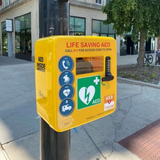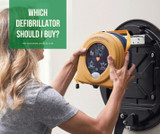What is an AED cabinet?
An AED cabinet, also known as an automatic external defibrillator cabinet is used to store defibrillators. Defibrillators are used to save a patient when they are suffering a sudden cardiac arrest. They scan the heart to determine whether a shock is needed and if so, will deliver one. This shock stops the heart from beating so that it can resume again at it’s normal pace naturally.
The success rate of a defibrillator can be as high as 90% if used within the first minute of someone falling ill. With many sudden cardiac arrests occurring outside of hospitals however, the more defibrillators that are installed around the country the better. But, where do you store an automatic external defibrillator?
A defibrillator can either be stored in a case or an AED cabinet. Cabinets not only keep defibrillators safe but, they also make them much easier to locate. Often, they are painted in a bright colour such as yellow or green and, have the medical AED symbol on for easy identification.
There are a number of different AED cabinets available, all suitable for different environments. Indoor AED cabinets for example, don’t need to protect the defibrillator from harsh weather such as rain and wind so do not require an IP rating. These types of indoor AED cabinets are typically found in schools or offices as they are easily identifiable and have easy access. Indoor AED cabinets can come alarmed or not alarmed.
When it comes to external AED cabinets however, there are typically more options. This is because, if stored outside, the risk of damage or theft is higher. Often dust and waterproof to protect against the elements, external cabinets are more robust in order to ensure the defibrillator inside remains safe.
There are varying safety and protection levels when it comes to external AED cabinets. With some offering IP66 rating, corrosion and impact resistance and a stainless steel clutch lock mechanism, they ensure the defibrillator always remains safe. On external cabinets, you will find that they are locked, not allowing access to the defibrillator. In order to access them, you need to call the emergency services who will then ask you for the location code on the AED cabinet, they will then give you a code which will allow you to unlock the cabinet and gain access to the defibrillator. This means that is can always remain safe inside the cabinet and only accessed when absolutely necessary.
Many external AED cabinets are also fitted with lighting inside so they are easy to identify when it is dark or foggy outside. LED lighting is often found on the number pad and lock so you can quick get inside. Being outside obviously leaves the cabinet open to the elements so, some cabinets also come built with an inbuilt thermostat in order to maintain the correct environment inside and prevent moisture damage.
It is really important to protect defibrillators from vandalism, natural damage and theft as they are costly pieces of medical equipment that can make the difference between life and death when in an emergency. If damage, it is possible that the defibrillator may not work or be faulty, meaning the opportunity to deliver life saving care is missed.
You can find defibrillators in many locations including schools, sports facilities, offices, supermarkets, your local town or village and airports. There is a national database which locates all of the public access defibrillators (PADs) in the UK so you can see where you closest located defibrillator is. Alternatively, next time you are on your way to the shops, at work or in your village, make a note of where you see a defibrillator stored, it could save a life.
Recent Posts
-
Empowering Communities: The Lifesaving Impact of CPR on Restart a Heart Day
Every year, on and around October 16th, an important event takes place - Restart a Heart Day. This a …16th Oct 2023 -
Which home defibrillator?
80% of all out of hospital cardiac arrests occur at home. Defibrillators are often available in loca …4th Dec 2022 -
Which defibrillator should I buy?
There are many defibrillators available on the market and it can become overwhelming knowing which o …4th Nov 2022




